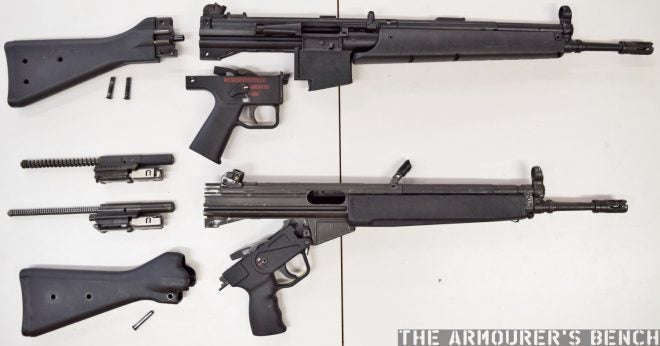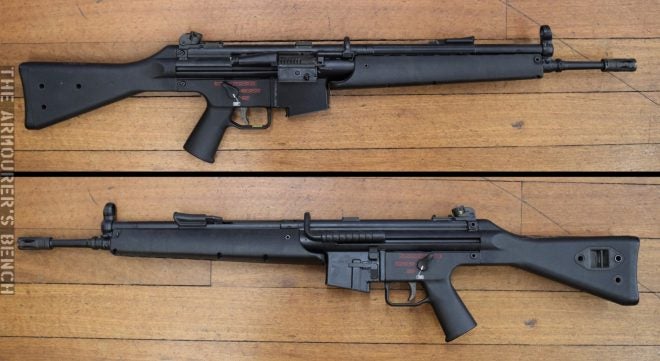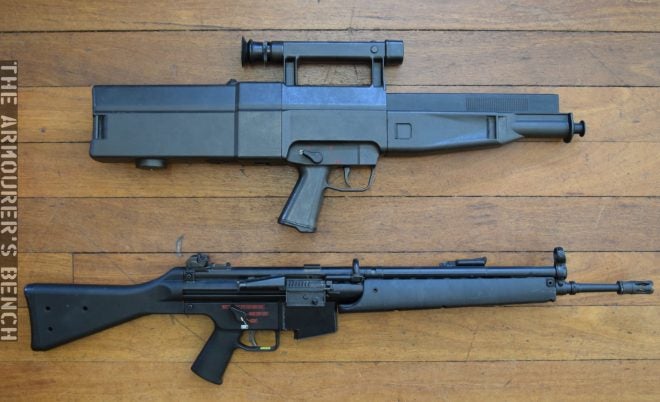When we think of Heckler & Koch in the 1980s we think of the famous G11, the iconic HK MP5 and the stylish P7 pistol. One rifle we don’t tend to think of is the G41, a 5.56x45mm chambered rifle designed to meet NATO’s new requirements. HK hoped the new rifle would be a hit with NATO countries looking to make the transition from 7.62x51mm to 5.56x45mm. Their hopes, however, were dashed and sales proved to be sluggish leading to the G41 to be one of HK’s lesser-known offerings and the company’s last roller-delayed blowback infantry rifle.
In 1980, NATO completed a series of trials that had tested arms and ammunition, with the final report recommending the standardization of the Belgian 5.56x45mm round, SS109. As a result, many European countries began to look for a new rifle to use the new standard ammunition. Heckler & Koch at the time were developing a number of rifles, with the G11 being their most expensive and time-consuming. Despite their focus on the G11 they saw the move towards 5.56 coming and began work on the G41.
The new rifle was designed to use the same magazines as the American M16A2 and added a couple of new features building on their earlier 5.56 rifle, the HK33, which used a proprietary type of magazine. The G41 essentially mimics many of the M16A2’s features – a forward assist, a last round hold open device and a bolt release position in the same place as the American rifle’s. It also introduced a three-round burst setting alongside the semi and fully automatic.
Here’s a gif showing the disassembly of the G41, check out the full video below:
Last summer I had the chance to look at an HK G41, and compare it side by side with the earlier HK33. In the photo below we can see the HK G41 at the top disassembled above the earlier HK33 (which was originally introduced in 1965). The two rifles are very similar but the G41 has a redesigned receiver with thinner, stronger steel and a redesigned buttstock and buffer system. Some of the geometries on the bolt, bolt head and carrier have been altered to work with STANAG magazines. Most notably in the bolt assembly is the recoil spring which has been altered too with a 5 strand wound spring instead of a single coil spring, this was intended to make the gun’s recoil more manageable.
Check out my video below showing the rifle in more detail:
The G41 also added a plastic dust cover and a spring loaded carrying handle. One of the G41’s advantages over its rival, the M16A2, was that it had ambidextrous selectors, with shorter throws, but the change to a STANAG magazine release meant the loss of the HK33’s more ambidextrous paddle magazine release. The bolt and magazine releases, unlike the M16, are both on the left side of the receiver.

The HK G41 (top) and the HK33 (bottom) field stripped. Note the HK33 has a single pin holding the buttstock in place while the G41 has two. Unlike the earlier HK33, the G41’s pistol grip assembly is not retained by a pin at the front of the assembly behind the magazine housing. (Matthew Moss)
So why wasn’t the G41 more widely adopted?
With the combination of the proven roller-delayed blowback action and the new features borrowed from the M16A2, at first glance the G41 should have been a sure-fire success. HK, however, struggled to find buyers for the G41. Sweden, Italy, Ireland and finally Germany all rejected the new rifle with Germany later adopting the G36, Italy going with the Beretta A70/90 and Ireland selecting the AUG. There were some sales to numerous special forces around the world including in Turkey, Argentina and Denmark but no major contracts. The primary reason for this appears to be the G41’s weight. Weighing in at 4.31kgs or 9.5 lbs unloaded, the new rifle was a full pound heavier than the HK33 and two pounds heavier than the M16A2 itself which weighed 3.39kg or 7.5 lbs. Reliability may have also been a factor, Ian over at Forgotten Weapons recently had a chance to fire a G41 and experienced some stoppages.
The G41 represents HK’s last roller-delayed blowback action infantry rifle. It remained in production for just over a decade before finally being replaced by the lighter weight G36 which abandoned the roller-delayed blowback action for a conventional gas-operated rotating bolt system. The failure of the G41 to find a market and the collapse of the G11 programme following the reunification of East and West Germany in 1990 led to a period of financial uncertainty for HK throughout the early 1990s.
You can find more photos of the G41 and a more in-depth history of the rifle here.
 Your Privacy Choices
Your Privacy Choices

